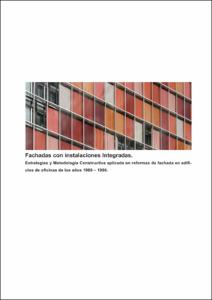Mostra el registre d'ítem simple
Fachadas con instalaciones integradas: estrategias y metodología constructiva aplicada en reformas de fachada en edificios de oficinas de los años 1960-1980
| dc.contributor | Avellaneda Diaz-Grande, Jaime |
| dc.contributor.author | Quintana Tapia, Fernando |
| dc.contributor.other | Universitat Politècnica de Catalunya. Departament d'Enginyeria de la Construcció |
| dc.contributor.other | Universitat Politècnica de Catalunya. Departament d'Estructures a l'Arquitectura |
| dc.contributor.other | Universitat Politècnica de Catalunya. Departament de Construccions Arquitectòniques I |
| dc.date.accessioned | 2013-11-13T15:17:03Z |
| dc.date.available | 2013-11-13T15:17:03Z |
| dc.date.issued | 2013-09 |
| dc.identifier.uri | http://hdl.handle.net/2099.1/19678 |
| dc.description.abstract | Este trabajo trata sobre identificar las principales estrategias y metodología constructiva en la reforma de fachadas, y más específicamente la integración de instalaciones mecánicas en el concepto de la envolvente. Un primer capítulo tratará sobe la puesta en valor de las actuaciones con los edificios existentes y evaluar los motivos, potencialidades y desafíos. En la siguiente parte del trabajo se analizará comparativamente, en dos capítulos, los parámetros de diseño climático y energético, y principios constructivos de la fachada de dos períodos tecnológicos entre 1960-1980 y la actualidad. Se establecerá un marco teórico en el que se estudiarán las fachadas y sus componentes con la analogía de software como el soporte normativo, aspectos energéticos y de confort interior; el hardware que serían los componentes físicos de las fachadas, formas constructivas y tipologías de fachada. En el siguiente capítulo se estudiará las principales estrategias de reforma de fachadas y la integración de instalaciones. Por último se analizaran cuatro casos de estudio que reflejen reformas actuales de edificios; se obtendrán conclusiones y se sugerirán recomendaciones y líneas estudios continuos a partir de este trabajo. Como parte de los resultados, se puede concluir que las fachadas de este período, a pesar de que parten de un número limitado de técnicas constructivas y de producción industrial, por geografía y época cambian notablemente su configuración. A pesar de ello, las fachadas pueden ser tipificadas y de acuerdo a sus características pueden efectivamente asignarse estrategias en función de los niveles de intervención, recursos del medio, y funciones que asumirá. Por otra parte, la evolución de los componentes de fachada y los sistemas ha sido gradual y difícil; se tenía el conocimiento de la técnica, la mejora de las prestaciones materiales y de los problemas ligados a la construcción ligera, pero estas aportaciones eran obviadas hasta hace relativamente pocos años. Por último, se puede sugerir que los próximos enfoques a la investigación de las tecnologías de fachada deberán estar orientados a mejorar la toma de decisiones, proceso de diseño y producción mediante la agregación de estudios de ciclos de vida más completos. |
| dc.description.abstract | The present Master Thesis identifies the principal strategies and construction methodology in façade refurbishment and more specifically the integration of service installations in the envelope’s concept. The first chapter will study the value of procedures with existing office space and evaluate motives, potentialities and constraints. In the next part will be comparatively analyzed, in two chapters, climate and energetic design parameters and façade construction principles of different periods, between 1960-1980 and current practice. Different façade types and components will be studied with the analogy of software as regulations and standards, energetic and comfort aspects, and the hardware as physical components and building forms. In the next chapter will be studied and evaluated the main façade refurbishment strategies and service integration concepts. Lastly, four case studies that reflect façade refurbishment with integration will be analyzed to obtain conclusions and suggest recommendations and extended studies from this Thesis. As part of the results, it can be concluded that the facades built in this period notably change their configuration by geography and year, even though they are based on a limited number of building technologies and industrial production. Also, facades can be typified and according to their characteristics can be effectively assigned refurbishment strategies depending on the levels of intervention, site resources, and new functions to be assumed. Moreover, the evolution of façade components and systems has been a gradual and difficult process. The technical knowledge, the progress of material and component’s performances and solutions to many difficulties linked to the lightweight construction was available, but all these improvements were obviated until relatively recent years. At last, it can be suggested that the next investigation scope in the façade technology and refurbishment should be oriented to better assessment methods for decision-making, improvement of the designing and production process by including mode complete life-cycle analysis. |
| dc.language.iso | spa |
| dc.publisher | Universitat Politècnica de Catalunya |
| dc.rights | Attribution-NonCommercial-ShareAlike 3.0 Spain |
| dc.rights.uri | http://creativecommons.org/licenses/by-nc-sa/3.0/es/ |
| dc.subject | Àrees temàtiques de la UPC::Arquitectura::Tipologies d'edificis |
| dc.subject | Àrees temàtiques de la UPC::Edificació::Elements constructius d'edificis::Elements de tancament |
| dc.subject.lcsh | Office buildings -- Energy consumption |
| dc.subject.lcsh | Facades -- Conservation and restoration |
| dc.subject.lcsh | Lightweight construction |
| dc.subject.other | Reforma de fachadas |
| dc.subject.other | Reforma de edificios de oficina |
| dc.subject.other | Fachadas ligeras |
| dc.subject.other | Fachadas integradas |
| dc.subject.other | Office building refurbishment |
| dc.subject.other | Facade refurbishment |
| dc.subject.other | Lightweight facades |
| dc.subject.other | Integrated facades |
| dc.title | Fachadas con instalaciones integradas: estrategias y metodología constructiva aplicada en reformas de fachada en edificios de oficinas de los años 1960-1980 |
| dc.type | Master thesis |
| dc.subject.lemac | Edificis d'oficines -- Consum d'energia |
| dc.subject.lemac | Façanes -- Conservació i restauració |
| dc.subject.lemac | Façanes lleugeres |
| dc.rights.access | Open Access |
| dc.audience.educationlevel | Màster |
| dc.audience.mediator | Escola Tècnica Superior d'Arquitectura de Barcelona |
| dc.audience.mediator | Escola Tècnica Superior d'Arquitectura del Vallès |
| dc.audience.degree | MÀSTER UNIVERSITARI EN TECNOLOGIA A L'ARQUITECTURA (Pla 2009) |


